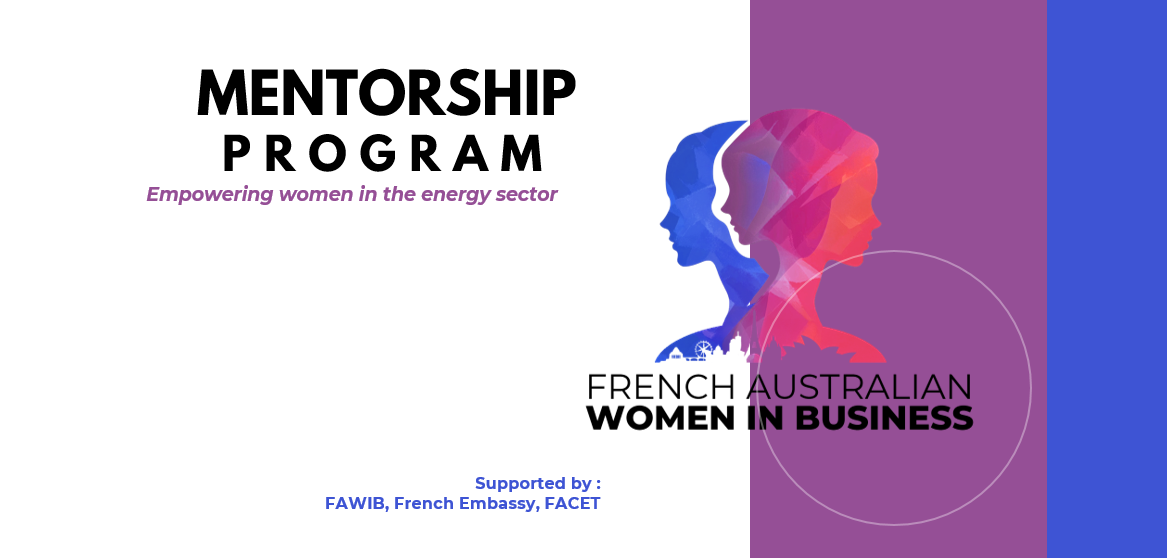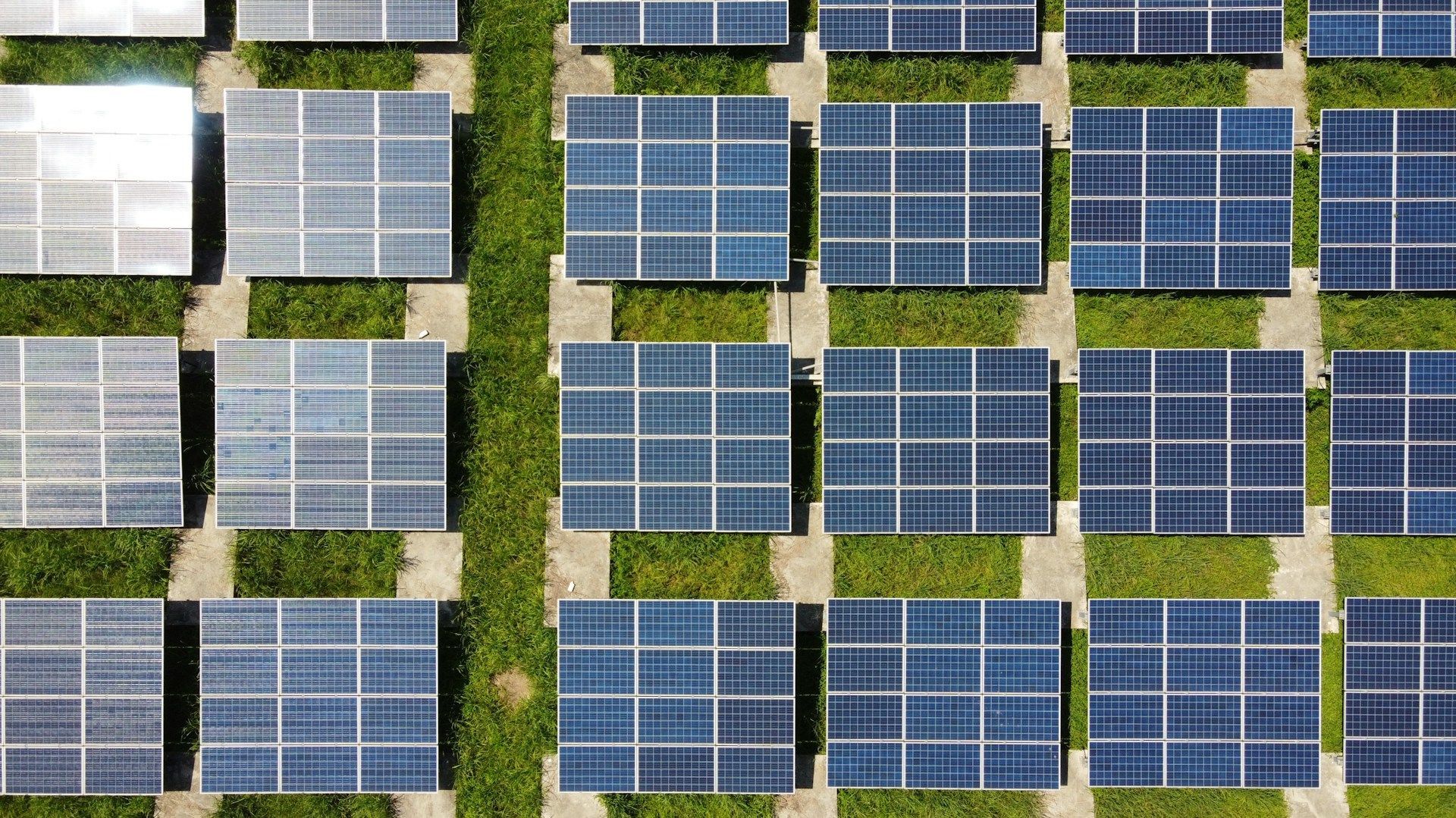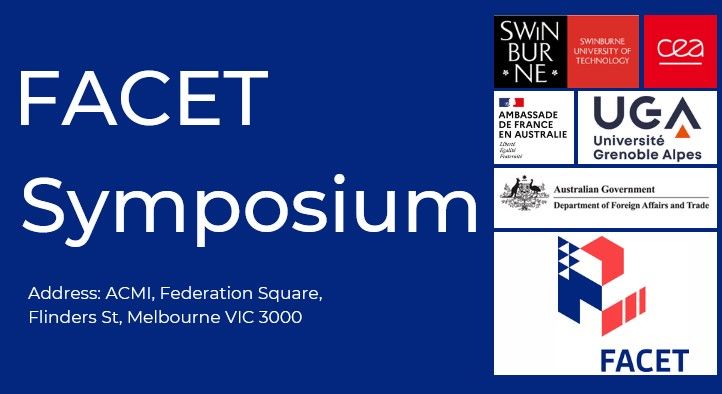Melanie Ducros • October 8, 2025
FACET launches six new Franco-Australian projects to accelerate the energy transition
The Franco-Australian Indo-Pacific Centre for Energy Transition (FACET) is excited to announce six new collaborative projects set to fast-track innovation and real-world impact in the global energy transition.
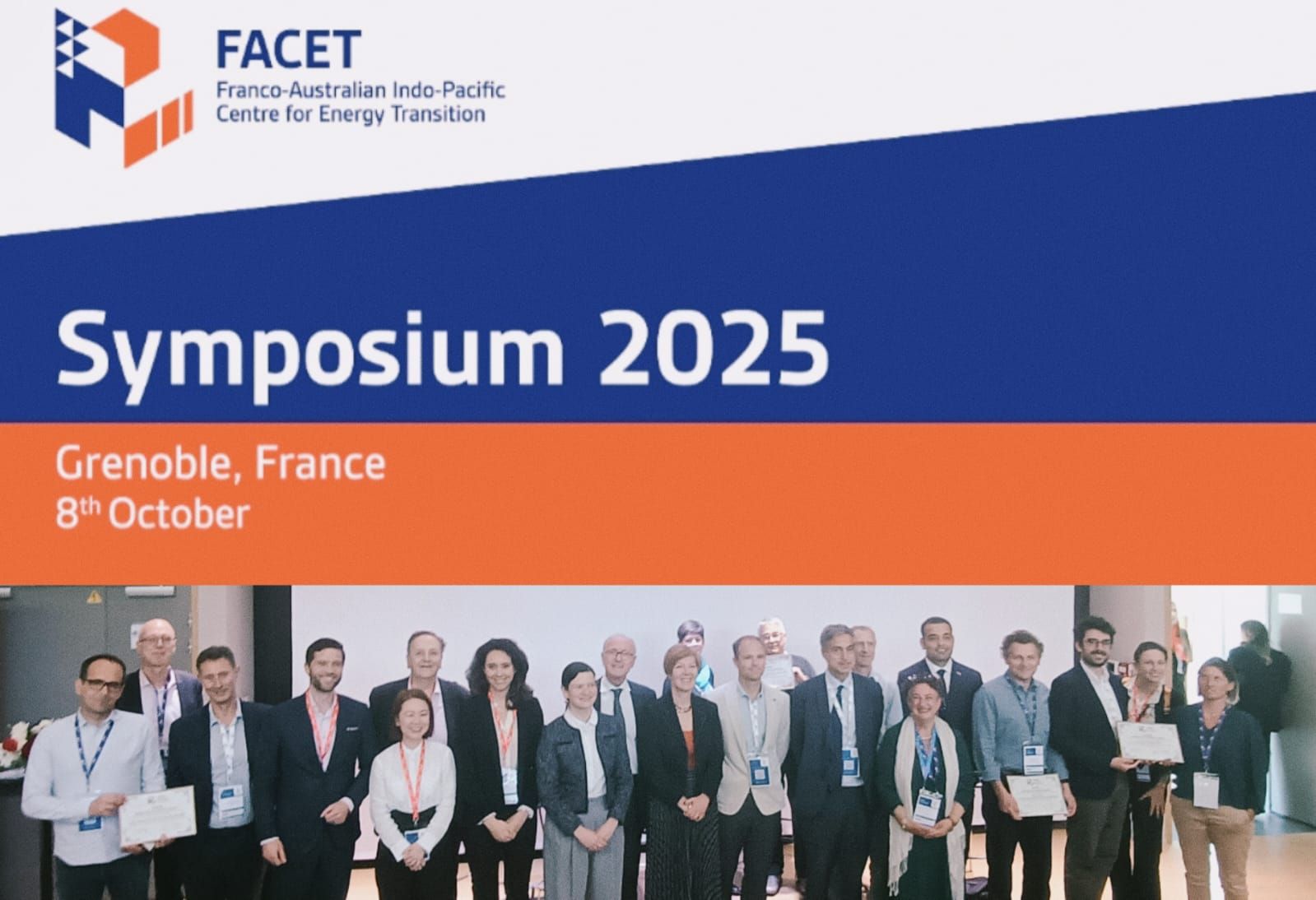
Unveiled in France at FACET’s second annual Symposium
on 8 October 2025, the announcement brought together senior leaders from research, industry and government across Australia and France - underscoring the deepening partnership between the two nations in tackling climate and energy challenges.
FACET set an ambitious goal for 2025: achieving at least 50% co-investment from project partners. That target has been decisively exceeded, with nearly AUD 3 million in co-investment secured, reflecting strong, shared commitment from both academic and industrial stakeholders.
The newly funded projects showcase the breadth, ambition, and impact of the FACET portfolio:
• Transforming mine waste into critical metals and green construction materials
through a circular economy initiative focused on resource recovery.
• A powerful simulation tool
to support Australia’s shift to flexible, renewable energy systems that deliver reliable electricity and heat.
• A French–Japanese–Australian collaboration
to unlock the export potential of green hydrogen across the Indo-Pacific.
• Unlocking liquid hydrogen storage
making it safer and more affordable for large-scale energy use.
• Fast tracking operations & maintenance for offshore wind
learning from operational teaming with unmanned systems.
• The launch of the Climate 4.0 Hub, a startup accelerator based at Swinburne University of Technology’s Hawthorn campus in Melbourne, connecting French and Australian entrepreneurs with innovation ecosystems and commercialisation pathways.
The announcement also coincided with a landmark moment: the largest ever Australian energy delegation to France, held as part of the FACET France Energy Transition & Innovation Tour, in partnership with the French Australian Chamber of Commerce & Industry (FACCI). Events across Paris, Lyon, and Grenoble provided a unique platform to deepen bilateral ties and showcase joint capabilities in clean energy and innovation.
As the global community faces the accelerating challenges of climate change and energy security, FACET continues to lead from the front - catalysing innovation, driving investment, and fostering high-impact international partnerships
for a more sustainable future.
Snapshots of 2025 projects
From mine waste to critical metals & green construction materials
TAILS - Tailings and Innovative Leverage for Sustainability - French Australian collaboration to advance global sustainability, energy transition and industry decarbonation by extracting critical metals from mine waste and recovering minerals for the construction sector.
Over 10 billion tonnes of mine waste, known as tailings, are produced globally each year - posing a serious environmental and safety threat due to the risk of dam failures and toxic leaks. Yet hidden in this waste are valuable critical metals, including rare earth elements (REEs) essential for clean energy technologies like EVs and wind turbines. In a game-changing collaboration, GHD, CEA and partners aim to recover these critical minerals and repurpose the non-metallic tailings into low-carbon construction products such as geopolymers, aggregates, and bricks. The project will use advanced mineral separation and testing to unlock value from tailings and build a scalable roadmap for full-scale rollout. By turning mine waste into a resource, the initiative not only reduces emissions, waste, and risk, but also strengthens strategic supply chains and promotes a circular economy.
“Ultimately, this project transforms an environmental liability into a strategic, economic, and sustainable asset,” said Charles Vuillier of GHD. “We're not just cleaning up mine waste - we’re unlocking its potential to power the clean energy future and provide the materials for some of the build of tomorrow.”
Partners: GHD, CEA – ISEC, BRGM, Invest Victoria
Dispatchable DC grid
DipatchGrid - Dispatchable DC grid: a flexible microgrid with intermittent generation and hybrid energy storage
This project is developing a powerful simulation tool to support Australia’s shift to flexible, renewable energy systems that deliver reliable electricity and heat. Using a 10 MW DC microgrid as a case study, it repurposes legacy infrastructure from retired coal-fired power stations, and integrates wind, solar, and advanced storage technologies - thermal, chemical, and electrical - to ensure a stable, dependable power supply. At its core is a digital prototype that tests different system setups, checks grid stability, and models cost-effectiveness. This virtual microgrid will form the foundation for a digital twin, giving industry and policymakers a practical tool to guide real-world energy planning and deployment.
According to Professor Gary Rosengarten, Director Sustainable Technologies & Systems, Enabling Impact Platform, RMIT
“This isn’t just a study - it’s a decision tool for a smarter energy transition. By reusing old infrastructure and testing systems digitally before rollout, we’re building a cleaner, more reliable and cost-effective energy future.”
Partners: RMIT, CEA LITEN, Storabelle, Rondo Energy, Université Grenoble Alpes, Australian Department of Energy, Environment and Climate Action
Tripartite green hydrogen
A tripartite approach to unlock Australia’s green hydrogen export potential to create sustainable hydrogen supply chains in Australia, France and Japan
This trilateral project between France, Australia, and Japan will deliver a decision-support tool to strengthen collaboration in all three countries. Specifically, the tool will help French and Australian companies prepare for bids and projects in Australia, while also assessing the most viable export pathways to Japan and France. The project also aims to map supply chain opportunities, highlighting investment prospects, and identifying new business opportunities across the three countries.
“This collaboration represents an important step forward in advancing global hydrogen innovation,”
said Dr Julie Mougin, Deputy Director for Hydrogen Technologies at CEA, and Gordon Chakaodza, Director of the Victoria Hydrogen Hub (VH2). They added, “by combining the strengths of France and Australia, we will generate vital data and insights that open opportunities for companies to engage in three of the world’s most significant hydrogen markets.”
Partners: CEA, Victorian Hydrogen Hub (VH2), Australian Hydrogen Council, Vireo Energy.
Towards a safe and reliable hydrogen storage
CHALIA: Condensation of Humid Air during Loss of Insulation Accident in LH2 tanks
The CHALIA project is tackling one of the biggest challenges in clean energy: making liquid hydrogen (LH2) storage safer and more affordable. While LH2 offers zero emissions and high energy for heavy-duty transport, it also comes with risks - like pressure build-up, boil-off gas loss, and potential tank rupture. Current understanding of transient behaviour following tank failure remains limited, and accurate predictions of boil-off rates, even under normal operating conditions, require further improvement. This international collaboration between FEnEx CRC, CEA, and UWA is developing advanced tools, experiments, and simulations to better understand and predict LH2 behaviour during normal use and accidents. The project combines lab-scale testing with full-scale tank trials to improve safety standards, reduce storage losses, and support wider adoption of hydrogen.
“This isn’t just about safety - it’s about unlocking hydrogen’s full potential as a clean energy solution. By understanding how LH2 behaves during storage, we can make it safer, cheaper, and ready for the real world.”
commented Professor Eric May, Future Energy Exports (FenEx) CRC.
Partners: Future Energy Exports CRC, CEA, University of Western Australia
Fast tracking O&M for offshore wind
LOTUSim-Energy (Learning from Operational Teaming with Unmanned Systems)
Operations and maintenance (O&M) of offshore wind turbines are complex, costly, and risky, requiring specialised vessels and equipment to handle harsh maritime conditions. Technicians and divers face significant safety hazards, and planning must account for failures and weather. Drones and autonomous systems offer a safer, more efficient alternative, but they still require complex prototyping before deployment. Simulation provides a way to model and validate solutions beforehand, reducing risks and costs. The project LOTUSim-Energy proposes the first cross-domain (air, surface, underwater) maritime simulation platform for testing and validating autonomous O&M processes. It will allow simulation of various offshore wind turbine locations, drone behaviours, and weather conditions for scenario experimentation and anomaly detection.
Partners: IRL Crossing, Naval Group, Swinburne University of Technology, Université Grenoble Alpes
Accelerating high-impact climate tech startups
Climate 4.0 Hub
The Swinburne-FACET Climate 4.0 Hub is a dynamic new initiative accelerating high-impact climate tech start-ups from Australia and France. Located in Melbourne, the Hub aims to act as an accelerator by supporting 5 to 10 start ups annually with hands-on mentorship, access to global investors, cutting-edge R&D, and pilot opportunities. Focused on clean energy, decarbonisation, critical minerals, and climate resilience, the Hub bridges industry and research to turn innovations into scalable solutions. By addressing the key "valleys of death" in climate tech commercialisation, the Hub will unlock new pathways for sustainable growth and position Australia as a regional leader in climate innovation.
"We’re excited to launch the Swinburne-FACET Climate 4.0 Hub and foster climate innovation and collaboration between Australia, France and the Indo-Pacific"
says Swinburne's Vice-President, Innovation and Enterprise, Werner van der Merwe. “Through our accelerated start up program, we’ll be providing targeted support and strong industry ties, which leverages the thriving innovation culture and capabilities offered by our in-house Swinburne Innovation Studio, to foster real-world impact with climate tech start-ups from Australia and France".
Partners: FACET, Swinburne University, Twynam Earth Fund, ARENA, Invest Victoria, Business France, French Australia Chamber of Commerce, CEA, Université Grenoble Alpes
Media contact: info@franceaustraliaenergy.com
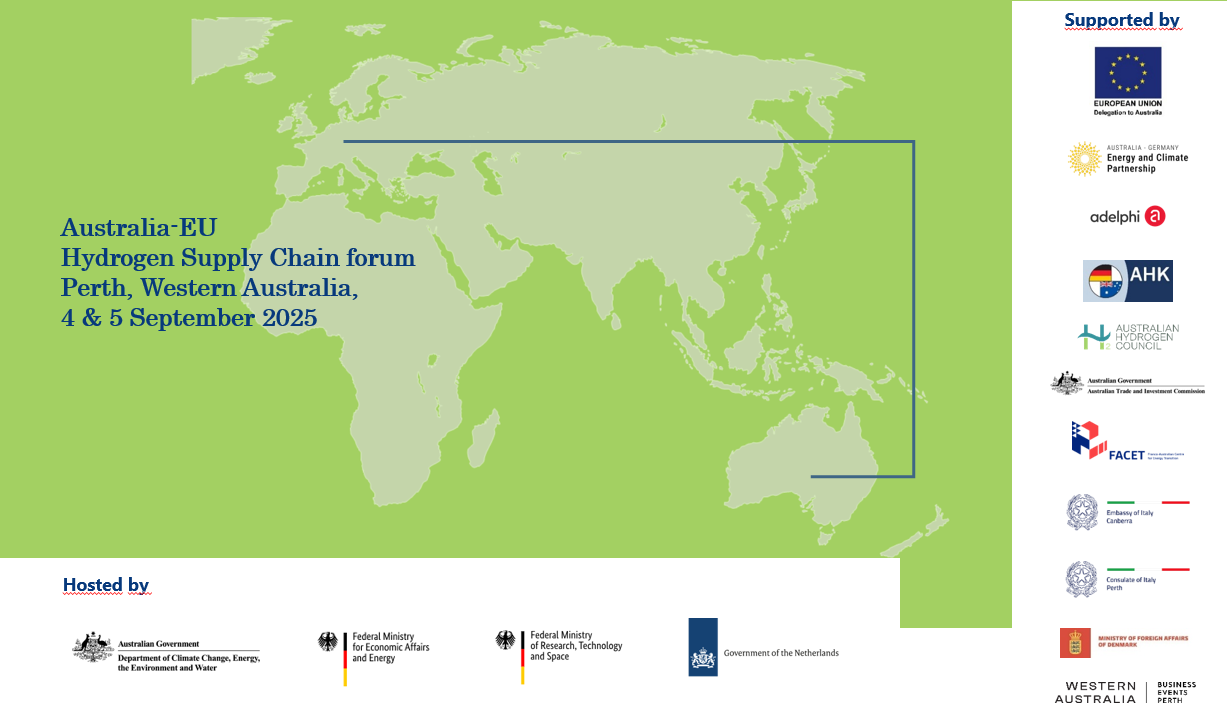
The Franco-Australian Indo Pacific Centre for Energy Transition (FACET) was honoured to take part in the Australia–EU Hydrogen Supply Chain Forum held in Perth. We warmly thank the organisers The German Embassy, The Embassy of the Netherlands, Adelphi & the German Chamber of Commerce and the EU Delegation in Australia, the Government of Western Australia, and Fortescue for their invitation and for hosting a week of high-level discussions, technical visits, and strategic exchanges. The event provided a valuable platform to showcase the growing strategic relationship between Europe and Australia in the hydrogen sector.
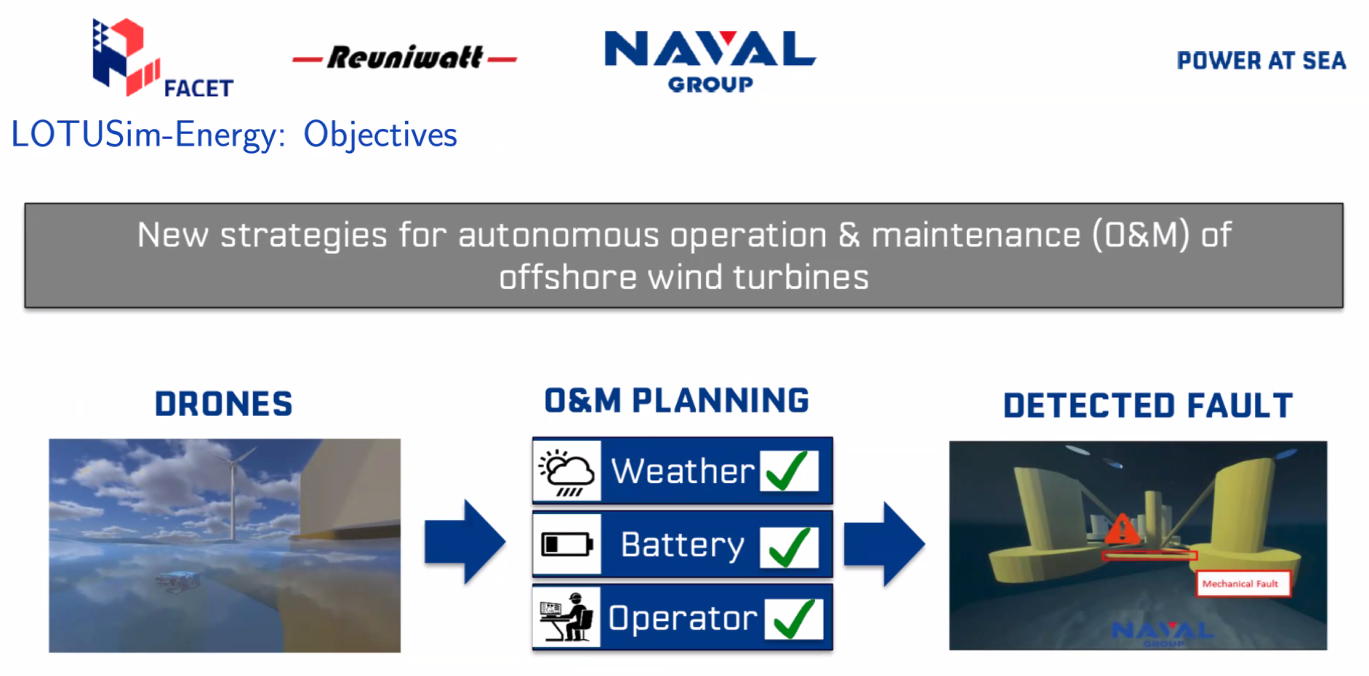
On July 28–29, the FACET team traveled to Adelaide to participate in a dedicated workshop on LOTUSim. This was a valuable opportunity to meet with the teams from IRL Crossing lab and CNRS , University of Adelaide and Flinders University, and to explore potential next steps for the project. These discussions helped strengthen collaboration and identify new directions for applying LOTUSim in energy transition contexts. A bout LOTUSim LOTUSim is a real-time maritime simulation platform, and Naval group has worked the past few months in designing it on case studies that unable it to support human-drone teaming in offshore wind O&M. The platform features realistic physics across air, surface, and underwater domains, making it a first-of-its-kind cross-domain simulator. Lotusim can simulate the behavior of underwater drones, but also surface vessels, aerial drones, and even marine mammals or birds, depending on the case study. Powered by AI, it supports a wide range of predictive scenarios for trajectories and interactions in both marine and aerial environments. The platform enables: Simulation of various offshore wind turbine locations Modeling of drone (submarine, boat and aerial) behaviors and weather conditions Scenario experimentation and anomaly detection for submarine drone for offshore wind maintenance Ultimately, operators could benefit from an immersive interface to monitor and manage simulated autonomous O&M systems for offshore wind. A market study for offshore wind applications FACET has funded a market study to explore the use of the platform for the offshore wind sector. While LOTUISim has clear applications in the maritime sector, this study—funded by FACET—explores its relevance for energy transition use cases. A restitution workshop was held on July 28, 2025, in Adelaide at Naval Group APAC, bringing together representatives from research, industry, and government from both France and Australia. A heartfelt thank you to all participants for their thoughtful and nuanced insights ! In this specific case study, submarine drones were simulated. However, discussions during the panel following the presentation highlighted other promising applications for offshore wind, such as the simulation of marine mammals or the use of drones for submarine cable maintenance. A Collaborative Approach Ultimately, the ambition is to make this project as collaborative as possible, by involving: Experts in relevant technical fields Companies in the energy transition sector Stakeholders with concrete case studies in the nergy transition to contribute This collaborative effort will help tailor Lotusim to the specific needs of the offshore wind industry, for the benefit of all. What’s Next? How to contribute ? In line with this vision, LOTUSim will be released as open source on November 1st, creating a platform for shared innovation in support of the energy transition. Feel free to reach out regarding the Lotusim project—especially to propose case studies or explore partnership opportunities. The FACET team would be delighted to support and foster collaboration around this initiative!
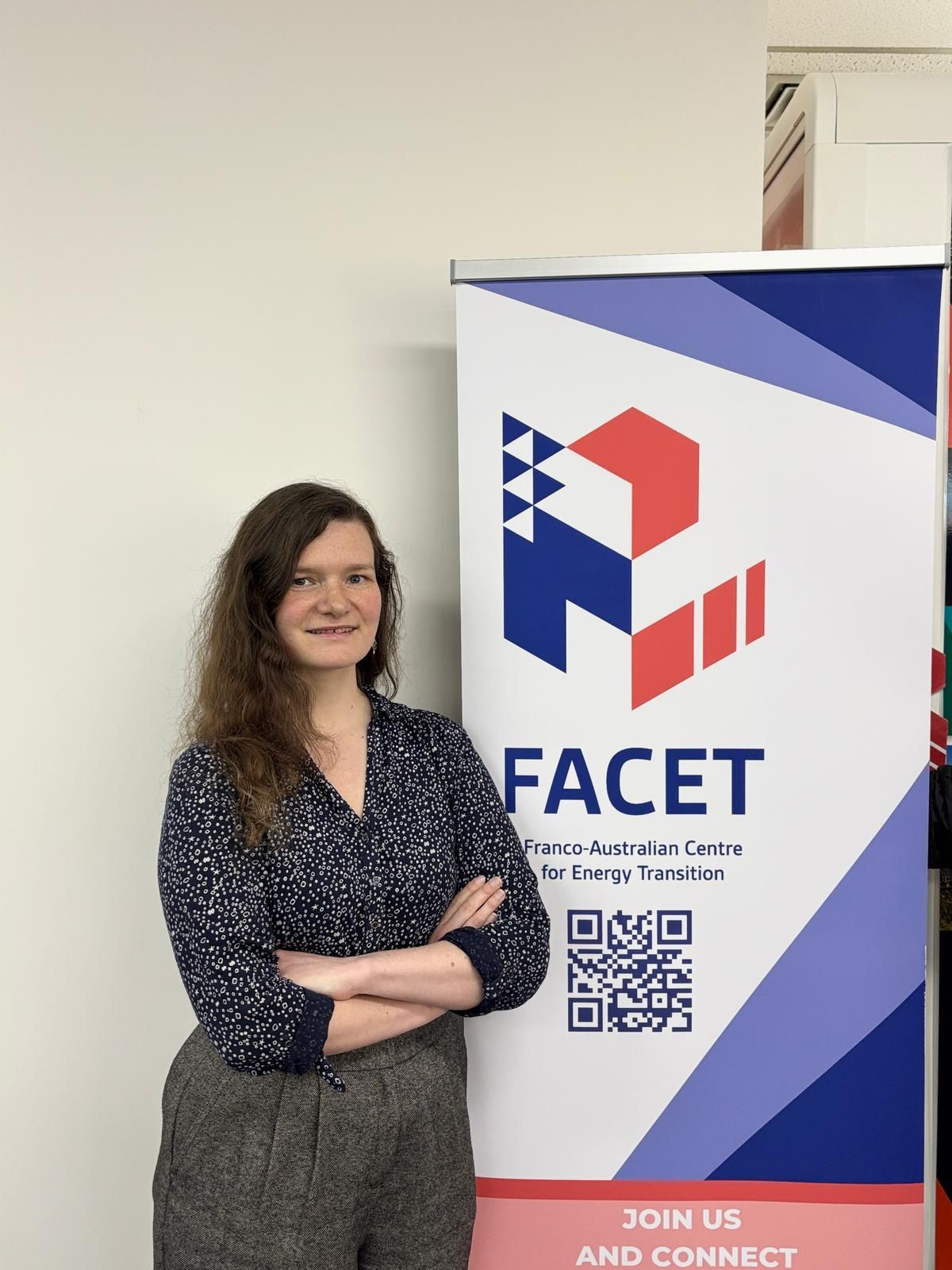
New Leadership to Drive Franco-Australian Energy Collaboration 28 April 2025 – The Franco-Australian Centre for Energy Transition (FACET) is thrilled to announce the appointment of Professor Joy Sumner as our new Co-Director. Professor Sumner has made the journey from Europe to Melbourne to help steer FACET's mission of fast-tracking clean energy adoption through international collaboration. Expert in Materials for Energy Systems Professor Sumner brings exceptional expertise as a metallurgist specialising in how materials perform under the extreme conditions found in various energy generation systems. "I'm a metallurgist by heart. I love metals. I love looking at them under a microscope and seeing all the detailed structures that they have," says Professor Sumner. "That is uniquely tied to the energy transition. If you ever look at how we generate power, it always uses slightly different machinery, and all of these generate their extreme operating conditions." Her research examines how metals degrade under high temperatures, pressures, and chemically aggressive environments—crucial knowledge for advancing sustainable energy technologies and ensuring their long-term performance. Bridging Science, Industry, and Policy Professor Sumner's career spans the intersection of research, industry implementation, and policy development. One of her most significant early projects investigated the effects of hydrogen combustion in gas turbines, examining corrosion issues and material performance when transitioning from methane to hydrogen fuel sources. "You go from the quite isolating experience of looking at bits of metal under a microscope and then seeing why it matters, how it's actually going to help us achieve net zero," she explains. "That feeling of things having significance, things having benefit to wider society... was incredibly motivating." Vision for FACET's Growth Having recently visited FACET's French co-founding partners, CEA and Université Grenoble Alpes, Professor Sumner is keen on the potential for international collaboration. "I'm really looking forward to the chance to make meaningful impact on the energy transition," she shares. "I love the fact that you've got that synergy between industry and academia across global boundaries. There's some fantastic engineering taking place in France, some fantastic engineering taking place in Australia, and there's a lot of potential for actually deploying new energy transition technologies." Her vision for FACET includes: Industry-Academia Partnerships : Strengthening collaboration between research institutions and companies across both countries Skills Development : Expanding educational programs to build capacity in the clean energy workforce Indo-Pacific Expansion : Extending FACET's impact beyond France and Australia into the broader region Policy Engagement : Working with governments to align research with national priorities First Year Success and Looking Ahead Professor Sumner is impressed with FACET's accomplishments in its first year of operation. "It's brilliant to see not just the academic and industry engagement, but also the engagement that's happening at a governmental level in both France and Australia," she notes. In the coming year, she hopes to "expand on that, bring more people in, get more areas for delivery, but also work on skills integration and bringing the wider public in." Complementary Leadership Prune, FACET's Co-Director, welcomes Professor Sumner's appointment with enthusiasm: "I believe Joy's profile is highly complementary to what France brings to FACET through my role as Co-Director. While my background is rooted in public policy and economic diplomacy, Joy brings deep technical expertise as a researcher, along with valuable experience collaborating with industry. I think effective leadership is built on complementarity rather than sameness—each of us contributes a different perspective, adding another brick to the FACET foundation." This partnership between complementary skill sets creates a strong foundation for FACET's mission, combining technical expertise with policy understanding to drive real-world implementation of clean energy technologies. Settling into Melbourne As she makes Melbourne her new home, Professor Sumner embraces local culture, particularly the city's world-class coffee scene. Like many Melburnians, she has developed her coffee preference: a long black, occasionally with a touch of sugar. About FACET The Franco-Australian Centre for Energy Transition (FACET) is a joint initiative bringing together academic institutions, industry partners, and government stakeholders from France and Australia to accelerate the development and deployment of clean energy technologies. Through collaborative research, knowledge exchange, and skills development, FACET aims to address the complex challenges of the global energy transition. Contact: About us | FACET Franco-Australian Centre for Energy Transition, energy transition
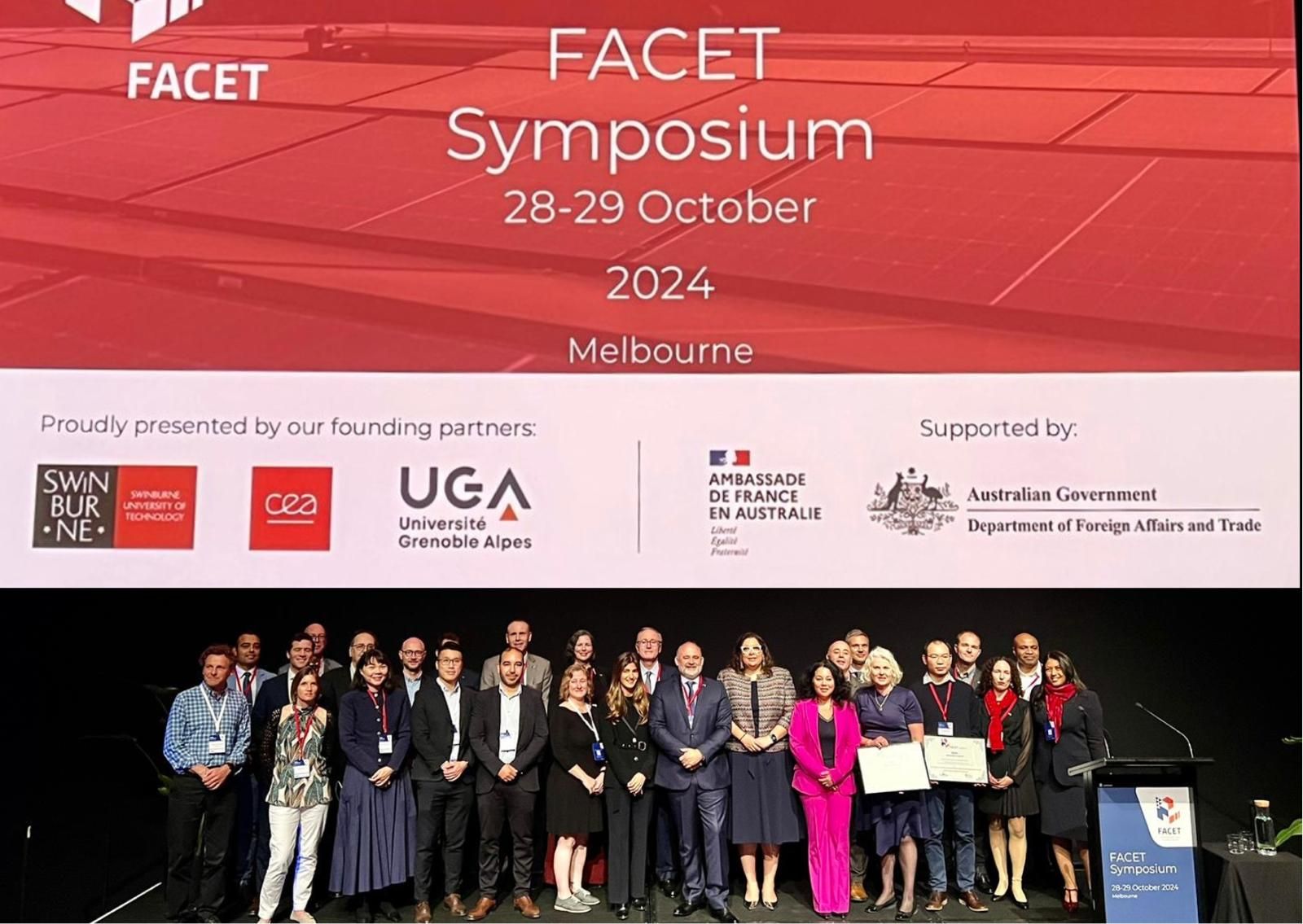
The Franco-Australian Centre for Energy Transition (FACET) is pleased to announce the first six recipients of the 2024 FACET grant, marking a significant step forward in fostering collaborative energy transition projects between France and Australia. This initiative is backed by financial support from both the French and Australian governments, each committing approximatively €1 million and AUD 1 million annually until 2027. This large-scale partnership is an unprecedented example of France and Australia’s shared commitment to advancing their bilateral roadmap in sustainable development and a greener future. In 2024 alone, FACET has already invested AUD 3.5 million, with additional co-investment from project partners, underscoring the centre’s value to both French and Australian companies. This initiative comes at a time when the energy transition is of increasing economic and political significance, highlighting the need for international cooperation in addressing critical energy challenges. On October 28th, at the inaugural symposium held in Melbourne, the six projects approved by the FACET Steering Committee were officially announced. These initiatives include two strategic programs designed to promote the adoption of innovative solutions by startups and to prepare the future energy workforce, alongside four applied research grants aimed at developing new French-Australian industrial-scale demonstrators. This year, FACET has expanded beyond its founding partners—the CEA Research and Innovation Centre, the University of Grenoble Alps, and Swinburne University of Technology (Host)—to include seven new academic partners across Australia and France: University of Sydney, Victoria University, Flinders University, and University of Adelaide, along with French institutions such as the East Paris Institute of Chemistry and Materials Science (ICMPE) and CNRS' CROSSING lab. In addition, more companies have joined FACET, bringing our network of First Movers in industry collaboration to over 20. These initial projects are helping FACET extend its reach beyond Victoria into New South Wales, Queensland, South Australia, and soon Western Australia, where an expert delegation from CEA, alongside a Business France mission on critical minerals with 30 French companies, will visit as part of the IMARC conference in Sydney. 6 projects launched in 2024 for an investment of 3.5 M AUD by FACET and its partners In collaboration with CEA, the Australian Group Downer is spearheading the development of a pilot industrial demonstrator for e-fuel production, targeting maritime and aviation sectors. This project will pave the way for synthetic fuel production in Australia, addressing emissions in hard-to-decarbonize industries. The team will work with FACET’s ‘First Movers’ companies, including end-user such as Airbus, CMA CGM & Safran, on the study. Murray Richards, Executive General Manager of Downer, highlighted the importance of collaboration, saying, "The energy transition is a complex challenge that requires collaboration and innovation. By working closely with universities, research institutions, and industry, we can unlock practical solutions that drive real impact." The EDF x FACET x Swinburne Startup Programme aims to connect French and Australian companies with startups offering innovative solutions for key energy transition challenges, such as energy storage, renewable energy, and transmission infrastructure. Startups will receive essential commercial and technical support through partnerships and access to EDF’s global network, accelerating Australia’s energy transformation. James Katsikas, CEO of EDF Australia, expressed his excitement about the collaboration, stating, "We are deeply committed to the global fight against climate change. This partnership enables us to combine that global expertise with local innovation to work alongside dynamic startups and to find new and impactful solutions that can accelerate Australia’s energy transition." FACET is also advancing three major applied research projects. One project, in collaboration with Flinders University, ICMPE, and CEA , will focus on future battery solutions, developing rechargeable batteries using organic materials to reduce reliance on lithium, emphasizing sustainability and safety. The second project, involving SUT, CSIRO, and CEA , will enhance community microgrids using advanced technologies for energy distribution and resilience. Also working on complex energy system and partnering with UGA and CNRS-IRL Crossing , University of Adelaide’s team will leverage AI to create smarter, more adaptable grids capable of managing variable renewable energy. Finally, FACET’s Skills Roadmap initiative will begin a study to identify the educational needs of the clean energy sector, preparing the future workforce for the energy transition in both France and Australia. Download the full press release
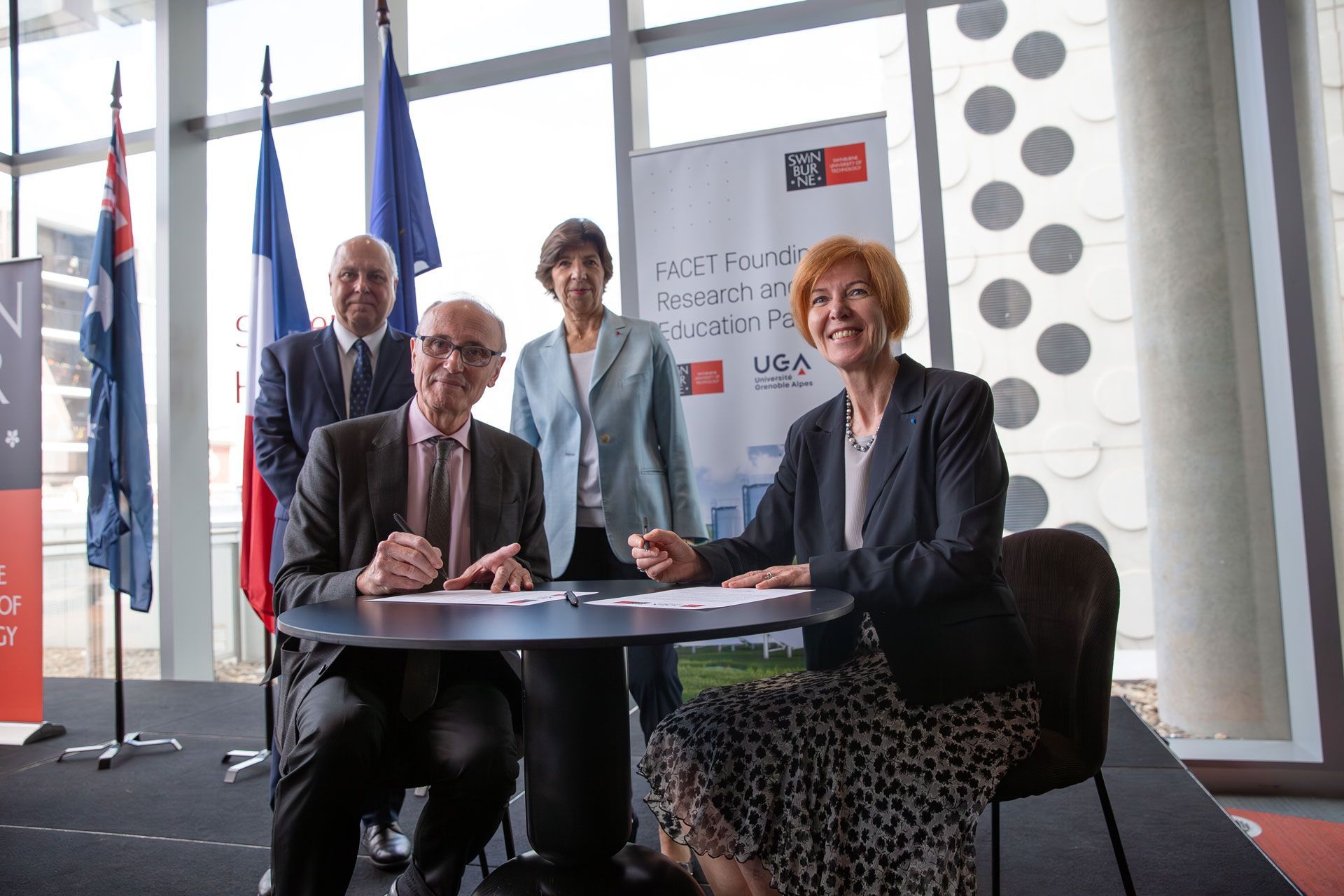
The French and Australian governments have announced a historic new partnership to tackle climate change, launching FACET: the French-Australian Centre for Energy Transition . Co-led by CEA, Université Grenoble-Alpes and Swinburne University of Technology (which is also the host of the centre), FACET will strengthen Australia and France’s bilateral relationship by building cooperation on sustainable and inclusive energy initiatives, and support energy transition needs in the Indo-Pacific region. FACET is a key deliverable under the resilience and climate action pillar of the France-Australia bilateral roadmap. Open to partners from universities, research and technology organisations as well as industries, FACET will enable joint activities in innovation, research, education and training, with a strong focus on energy transition, through leadership, low-carbon energy production and supply chain decarbonisation. The centre will support wider adoption of sustainable energy solutions, support multilateral partnerships and advance education and skills to support an ambitious climate change response agenda. French Minister for Europe and Foreign Affairs, Catherine Colonna, and the Australian Assistant Minister for Foreign Affairs, The Hon Tim Watts MP announced the joint endeavour during a visit to Swinburne’s Hawthorn campus. “Global challenges require global solutions. Today, represents an important step forward in our efforts to tackle one of the biggest threats our world faces – climate change – and work towards net zero,” said President and Vice-Chancellor, Swinburne University of Technology, Professor Pascale Quester. “Swinburne is proud to play host to this ground-breaking partnership between France and Australia, reflecting our nations’ shared energy transition ambitions and utilising our world-leading scientific and industry-linked commercialisation capabilities.” Jean-Louis Falconi, Director of International Relations of CEA declared: “CEA and Université Grenoble-Alpes are proud to be alongside Swinburne University of Technology, the founding partners of the new ambitious and promising French-Australian centre for the energy transition. We look forward to jointly developing cooperation on sustainable and inclusive energy initiatives and supporting energy transition needs in the Indo-Pacific region.” About Swinburne, CEA and Université Grenoble Alpes (UGA) Swinburne University of Technology As a dual-sector university, Swinburne offers the unique combination of excellence in research, teaching, skills development and commercial innovation needed to facilitate FACET’s energy transition objectives. The centre will utilise Swinburne’s world-leading strengths in the hydrogen economy, renewable generation systems, energy storage systems, future energy networks and supply chain decarbonisation. It will also bring together capabilities in artificial intelligence (AI), digital and supercomputer research, remote sensing, learning development, commercialisation and work-integrated learning. CEA research and innovation centre CEA is a major French research organisation with strong roots in fundamental research, that provides tangible solutions to meet industrial and societal needs in four key fields: low-carbon energy (nuclear and renewable); digital technology; technology for medicine of the future; defence and national security. Thanks to its integrated energy vision, and its industrial strong connections, CEA plays a key role in the R&D for energy transition in France. This knowledge in various technological fields will be shared within the FACET framework. Université Grenoble Alpes (UGA) UGA is a leading European comprehensive university. Academically, UGA is ranked in the top 150 of ARWU Shanghai’s ranking. UGA is a research-intensive university developing cutting age research from basic to applied research. Located in the heart of the French Alps, UGA is renowned for its scientific and technological research activities, aimed at providing essential training to students and faculty and at addressing societal issues. UGA is very active internationally, with 1,100 partnerships with foreign universities. 17% of its 60,000 students and 47% of its 2,700 PhDs are foreigners, and 155 nationalities are represented. 25% of its Masters courses are taught in English.
